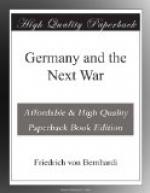If the frontal development of the artillery of a modern army corps, or, better still, two divisions, be regarded from the point of view that the guns cannot advance in connected line, but that only the specially adapted parts of the field can be used for artillery development, the conclusion is certain that by such frontal extension the infantry is reduced to a covering line for the artillery. In forming this opinion we must not assume the normal strength of the infantry, but take into account that the strength of the infantry in war rapidly melts away. If we estimate the companies on the average at two-thirds of their proper strength, we shall be above rather than below the real figures. Such infantry strength will, of course, be sufficient to defend the position taken up by the artillery, but it is hardly enough to carry out, in that section of the field, a decisive attack, which, under present conditions, requires greater numbers and depth than before.
In this connection it is very instructive to study the second part of the Franco-German War, and the Boer War, as well as the Manchurian campaign.
Some of the German infantry had in the first-named period extraordinarily diminished in numbers; companies of 120 men were not rare. The artillery, on the contrary, had remained at its original strength. The consequences naturally was that the powers of the Germans on the offensive grew less and the battles and skirmishes were not so decisive as in the first part of the war. This condition would have shown up more distinctly against an enemy of equal class than in the contest with the loosely-compacted, raw French levies. In the former case the offensive would have been impracticable. The strong artillery, under the existing conditions, no doubt gave great support to the weak infantry; but an unbiassed opinion leads to the conclusion that, under the then existing proportion of the arms to each other, the infantry was too weak to adopt energetic offensive tactics against a well-matched enemy. This is irresistibly proved if we consider what masses of infantry were needed at Woerth and St. Privat, for instance, in spite of the support of very superior artillery, in order to defeat a weaker enemy of equal class.
Again, in South Africa, the overwhelming superiority of the English in artillery was never able to force a victory. In Manchuria the state of things was very instructive. Numerically the Russian artillery was extraordinarily superior to the enemy’s, and the range of the Russian field guns was longer than that of the Japanese; nevertheless, the Japanese succeeded in beating an enemy stronger in infantry also, because, in the decisive directions of attack, they were able to unite superior forces of infantry and artillery, while the Russian artillery was scattered along the whole of their broad front.
The lesson of this war is that, apart from the close relation of the arms to each other in the separate units, the co-operation of these units must be looked at, if the strength of the two sister arms is to be appropriately determined.




